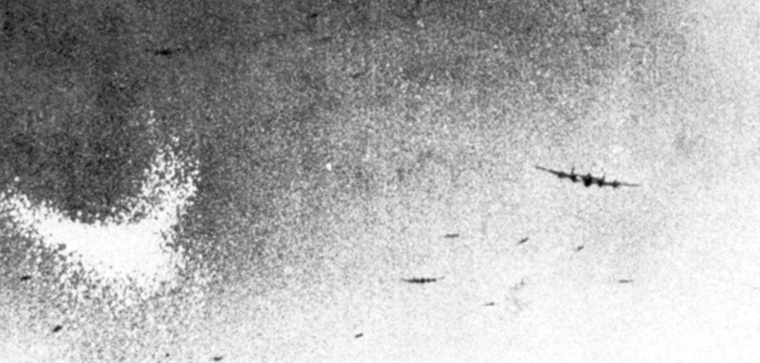










A brief history of Chaff
Chaff, originally called Window by the British and Düppel by the Second World War era German Luftwaffe, is a radar countermeasure in which aircraft or other targets spread a cloud of small, thin pieces of aluminium, metallized glass fibre or plastic, which either appears as a cluster of primary targets on radar screens or swamps the screen with multiple returns.
Modern armed forces use Chaff (in naval applications, for instance, using short-range SRBOC rockets) to distract radar-guided missiles from their targets. Most military aircraft and warships have chaff dispensing systems for self-defence. An intercontinental ballistic missile may release in its midcourse phase several independent warheads as well as penetration aids such as decoy balloons and chaff.

A Lancaster dropping Chaff. Photo RAF
In 1937, British researcher Gerald Touch (who was working with Robert Watson-Watt on radar) suggested that lengths of wire suspended from balloons or parachutes might overwhelm a radar system with false echoes and R. V. Jones had suggested that pieces of metal foil falling through the air might do the same.
 Chaff containers.In early 1942, a Telecommunications Research Establishment (TRE) researcher named Joan Curran investigated the idea and came up with a scheme for dumping packets of aluminium strips from aircraft to generate a cloud of false echoes. An early idea was to use sheets the size of a notebook page; these would be printed so they would also serve as propaganda leaflets. However, it was found the most effective version used strips of black paper backed with aluminium foil, exactly 27 by 2 centimetres (10.63 in × 0.79 in) and packed into bundles each weighing 1 pound (0.45 kg). The Head of the TRE, A. P. Rowe, code-named the device "Window".
Chaff containers.In early 1942, a Telecommunications Research Establishment (TRE) researcher named Joan Curran investigated the idea and came up with a scheme for dumping packets of aluminium strips from aircraft to generate a cloud of false echoes. An early idea was to use sheets the size of a notebook page; these would be printed so they would also serve as propaganda leaflets. However, it was found the most effective version used strips of black paper backed with aluminium foil, exactly 27 by 2 centimetres (10.63 in × 0.79 in) and packed into bundles each weighing 1 pound (0.45 kg). The Head of the TRE, A. P. Rowe, code-named the device "Window".
 The effect of chaff on the display of a Giant Würzburg radar.
The effect of chaff on the display of a Giant Würzburg radar.
The effect of jamming appears in the left "jagged" half of the circular ring, contrasting with the normal "smooth" (unjammed) display on the right half of the circle, with a real target at the 3 o'clock position - on the jammed left side the real target "blip" would have been indistinguishable from the jamming.
Modern armed forces use Chaff (in naval applications, for instance, using short-range SRBOC rockets) to distract radar-guided missiles from their targets. Most military aircraft and warships have chaff dispensing systems for self-defence. An intercontinental ballistic missile may release in its midcourse phase several independent warheads as well as penetration aids such as decoy balloons and chaff.

A Lancaster dropping Chaff. Photo RAF
In 1937, British researcher Gerald Touch (who was working with Robert Watson-Watt on radar) suggested that lengths of wire suspended from balloons or parachutes might overwhelm a radar system with false echoes and R. V. Jones had suggested that pieces of metal foil falling through the air might do the same.


The effect of jamming appears in the left "jagged" half of the circular ring, contrasting with the normal "smooth" (unjammed) display on the right half of the circle, with a real target at the 3 o'clock position - on the jammed left side the real target "blip" would have been indistinguishable from the jamming.
 |
 |
 Copyright © 2024 Pilot's Post PTY Ltd
The information, views and opinions by the authors contributing to Pilot’s Post are not necessarily those of the editor or other writers at Pilot’s Post.
Copyright © 2024 Pilot's Post PTY Ltd
The information, views and opinions by the authors contributing to Pilot’s Post are not necessarily those of the editor or other writers at Pilot’s Post.